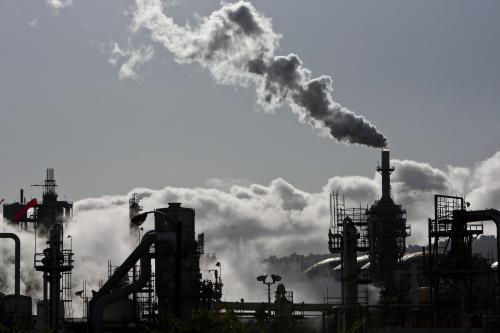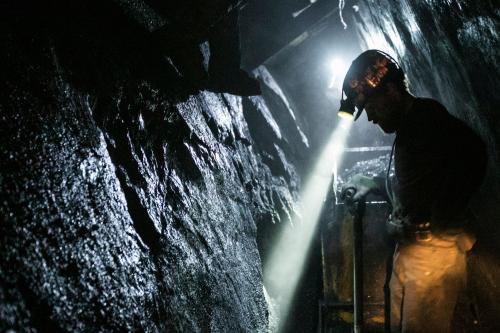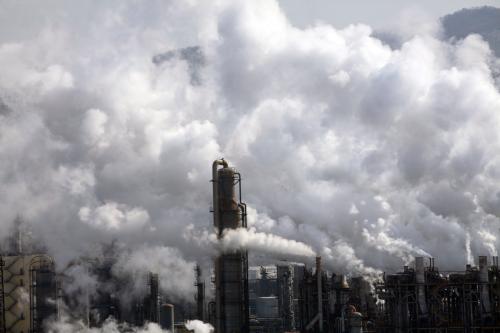This post was updated on December 10, 2018 to reflect accurate voting results of the states that emitted the most energy-related carbon per capita.
Recently my colleague Sifan Liu and I came across a stark, under-recognized split in last month’s election returns. Our observation: President-elect Trump will govern a largely metropolitan nation with his main support coming predominantly from hundreds of low-output rural or small-town counties containing just one-third of the nation’s economic activity.
The result: A historically sharp political divide now exists between what Washington Post reporter Jim Tankersley labeled “high-output” and “low-output” America.
Here’s what that divide looks like:

Yet now it’s time to add another divide to an accumulating list of election analyses that includes trade stress, opioids, and economic anxiety as expressed by “routine” jobs. The new addition is the carbon divide, stressed this week by Ron Brownstein of The Atlantic in a revealing analysis of the data presented in the Metropolitan Policy Program’s new study of state-level emissions “decoupling” trends.
To be sure, it’s not new to suggest that Clinton-voting “blue” states might be more ideologically sympathetic to President Obama’s strong carbon-reduction agenda than Trump-voting red states. However, what is striking, notes Brownstein, is the extremely tight alignment between states’ emissions and politics preferences. This alignment shows how very strongly economic self-interest shapes and reinforces ideology.
Take a look at this table, paralleling Brownstein’s chart and adding coal to the mix. The table shows how states voted alongside information on their 2015 per capita carbon emissions.

Scrolling down the table, it’s immediately evident that the states with the highest carbon emissions (and often the heaviest dependency on carbon-intensive fuels, namely coal) tended almost monolithically to vote for Trump, who has lambasted the “decarbonization” paradigm and steps to advance it, such as the Environmental Protection Agency’s Clean Power Plan to reduce pollution from power plants.
The alignment is sharp: Twenty of the 22 of the states that emitted the most energy-related carbon per capita voted for Trump over Clinton last month, including, in order, Wyoming, North Dakota, West Virginia, Alaska, Louisiana, Montana, Kentucky, Indiana, Nebraska, Oklahoma, Iowa, Texas, and Alabama. Overall, Trump carried 27 of the 32 states that emit the most energy-related carbon per capita.
By contrast, the bottom of the table shows the flipside of carbon politics. Hillary Clinton carried all eight of the states (plus the District of Columbia) that emit the least energy-related carbon and 16 of the lowest-emitting 19, with the exceptions of Florida, North Carolina, and Idaho. Along these lines, while Trump carried nearly all of the most fossil fuel oriented states, Clinton carried nearly all of the lowest-carbon states, ranging from New York, California, Vermont, Massachusetts, and Oregon to Maryland, Washington, and Virginia.
Along these lines, it is easy to perceive a stark kind of economic determinism in which carbon politics follow ineluctably from self-interest shaped by the carbon-intensity of the economic base. As Brownstein notes in his piece, “Energy policy wasn’t the principal reason those states [voted as they did]. But carbon emissions illuminate a state’s broader economic structure.”
Or to put a finer point on it: The high-emitting mostly red states are heavily invested in the fossil-fuel economy, either as producers of oil, natural gas, and coal, or as large consumers of low-cost, coal-powered electricity (partly because several are manufacturing centers. Blue states rarely produce fossil fuel, are embracing low-carbon energy sources, and generate less carbon because they have embraced digital and other services in their economy. These states are often heavily urban and therefore efficient.”
In short, the election outcomes reflect the limited progress of the nation’s struggle to clean up its economy and reduce carbon emissions. Although low-carbon America has little to lose and much to gain from low-carbon policies such as the Clean Power Plan with its rules on coal-burning generating plants, high-carbon America believes it has much to lose from them–and voted accordingly. That vote has complicated the achievement of further progress globally, and perhaps domestically, to say the least.
And yet a caution against determinism is in order, and it arises from the surprising progress being made in many states as depicted in the Brookings study. To be sure, last month’s vote reflected last year’s carbon status in snapshot. But other findings in the Brookings analysis depict an energy system in transition, in which economic growth is being “decoupled” in 33 states from emissions growth, and in which red states are making some of the fastest progress thanks to major fuel and market dynamics.
This map from the new Brookings report highlights that process:

In scanning this map it’s clear that carbon emissions are declining in dozens of states, as coal plants are shut down and cheap natural gas and renewables spread, and that the change is occurring fastest in a number of high-carbon states. Notice that some of the states that are seeing emissions decline the fastest (darkest shades) include not just classic low-carbon blue states such as Massachusetts and New York but key Trump provinces such as Georgia and Tennessee, closely followed by other Trump states such as Alabama, Indiana, North Carolina, and Pennsylvania. It’s also worth noting the strong growth of renewables in such Midwestern red states as Iowa, Kansas, South Dakota, Idaho, Oklahoma, and Texas which also augurs for change.
In short, although voting behavior in these transitioning Trump states still reflects their high emissions per capita, those emissions are declining fast, with possible implications for future politics. The nation’s carbon divide, in sum, might be more transitory than some of its other divides.
The Brookings Institution is committed to quality, independence, and impact.
We are supported by a diverse array of funders. In line with our values and policies, each Brookings publication represents the sole views of its author(s).







Commentary
Another Clinton-Trump divide? Low-carbon vs. high-carbon America
December 15, 2016